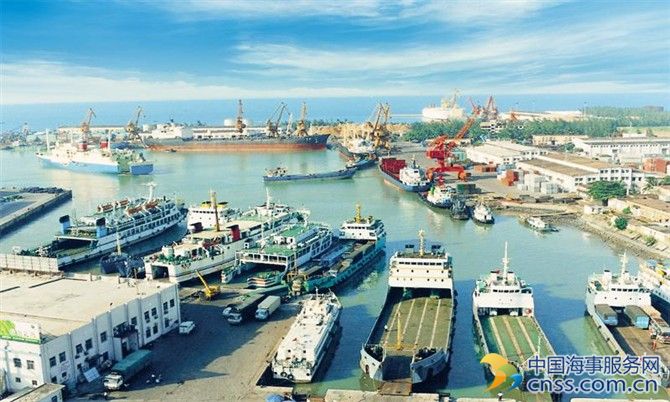Major ports of India register 6.79% traffic growth in FY2017

The twelve major ports under the Ministry of Shipping handled a record 647.43 million tonnes (mt) of traffic in 2016-17, registering an annual growth rate of 6.79%, as against 4.32% last year. With this, these ports have out- performed private ports for the second consecutive year. The private ports have registered a traffic growth rate of 4% this year.
The top position in cargo handling was retained by Kandla Port that handled 105.44 mt of cargo, registering a growth of 5.39% over last year. This was followed by Paradip Port with 88.95 mt of cargo handled, and an impressive growth rate of 16.45%. Mumbai Port holds the third position with 63.05 mt of cargo handled and growth rate of 3.17%.
JNPT recorded highest ever handling of 4.50 million TEUs during 2016-17. The port owned terminal, JNPCT, achieved highest ever handling of 1.53 million TEUs during the year, registering a growth rate of 7.33%.
Iron-ore traffic attained the highest growth rate of 163.67%. Other miscellaneous and general cargo grew by 18.53% and POL products by 8.16%.
In terms of Operating Surplus too, the Major Ports have shown highest ever achievement in 2016-17. JNPT net surplus has crossed Rs. 1300 crore as against Rs. 1091 crore of 2015-16. Kandla Port posted its highest ever net surplus of Rs. 651 crore during 2016-17, an increase of 54.4% over last year’s profit of Rs 422 crore.
For the first time ever, JNPT raised Foreign Denominated Loan of US $400 million. It became the first major port to raise foreign currency loans. Kamarajar Port Limited (Ennore) is also in the process of raising USD $100 million foreign currency loan. This mode of financing at low interest rates and natural hedging has been followed in the Major ports for their infrastructure development for the first time.
The major ports have also recorded the highest ever capacity addition of 100.37 mt during 2016-17. The capacity of major ports during 2015-16 was 965.36 MTPA. This crossed 1065 MTPA during 2016-17.
In respect of development of port infrastructure, 56 projects have been awarded with a capacity of 103.52 MTPA against a target of 102 MTPA with an investment of Rs. 9490.51 crore during 2016-17.
The efficiency indicators in major ports are also improving steadily. During 2016-17, total turn-around time came down to 3.44 days as against 3.64 days during last year. Likewise, Average Output Per Ship Berthday has gone up to 14583 tonnes as against 13748 tonnes during last year.
Major Ports have been benchmarked to international standards. 116 initiatives were identified. Out of these, 70 initiatives have been implemented and remaining will be implemented by 2019. This has resulted in unlocking 80 MTPA capacity. Implementation of these initiatives would further improve the efficiency & productivity of the Major Ports.
Mumbai Port has become Home Port for cruise tourism. Asia’s largest passenger ship ‘Genting Dream’ with a capacity of 3,400 guests anchored at Mumbai Port on 29th October, 2016. The ship also ferried 1,900 passengers from Mumbai to Singapore via Colombo. 51 cruise vessels have called at Mumbai Port during 2016-17. A total number of 158 Cruise vessels anchored at 5 Major Ports during 2016-17, registering an increase of 23% over 2015-16.
In addition to the outstanding performance of the ports, the Ministry has taken several initiatives. The dredging of Mumbai Channel and JNPT Channel phase – II has been awarded to increase draft upto 15 meters at an estimated cost of Rs. 1963.17 crore. Smart Port Industrial Cities are being developed at Paradip and Kandla, Master Plans for which have been finalised. Multi Modal Logistic Park is being set up in Paradip.
The Ministry of Shipping has initiated several Policy during the year. The New Captive Policy guidelines were issued in July, 2016 to ensure uniformity and transparency in the procedure for awarding captive facilities in the ports. This will allow concessionaire to handle non captive cargo upto 30% of the designed capacity of the berth.
The New Berthing Policy came into effect from August, 2016. This policy provides standardized framework for calculation of norms, specific to the commodity handled and infrastructure available on the berth. This will improve the efficiency at ports and productivity norms across ports.
The New Stevedoring Policy has been implemented since July, 2016. This will improve productivity, efficiency and safety in the ports.
The existing Model Concession Agreement of 2008 is under process of revision which will address the concerns of PPP projects and prevent them from getting stressed.
The Major Port Authorities Bill has been introduced in the Lok Sabha in December, 2016 to modernize the institutional structure of the ports to usher in professional governance in the ports.
Source: Business Standard
HEADLINES
- Do shipping markets want Biden or Trump for the win?
- All 18 crew safe after fire on Japanese-owned tanker off Singapore
- Singapore launching $44m co-investment initiative for maritime tech start-ups
- Cosco debuts Global Shipping Industry Chain Cooperation Initiative
- US warns of more shipping sanctions
- China continues seaport consolidation as Dalian offer goes unconditional